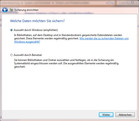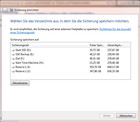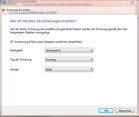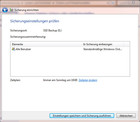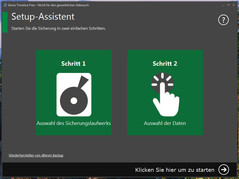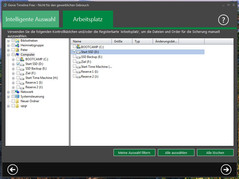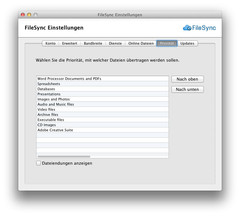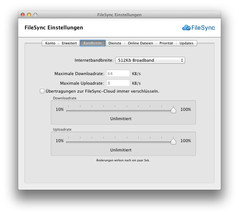FAQ: Creating Backups
For the original German article, see here.
A complete loss of data usually comes unexpectedly and quicker than you'd think. Just a power surge, a power outage or a virus attack can be enough to cause irreversible consequences. Then, just like that, the data is gone, and sometimes the hard drive is corrupted as well. The only way to recover data in dire situations like that is to have an archived copy -- a backup. Everyone knows this. But it seems most people only consider it important once they've already had to swallow the pill of lost data. Others know it's imperative, but they only secure their data once in a while. Unfortunately, backups are only truly effective when they are performed regularly. To accomplish this you need either discipline or a "backup solution" -- a means by which data is automatically copied into a secure location. A backup solution clearly has its advantages over securing data manually: You can't forget to do it, and it saves time and energy.
What data should be backed up?
Once we've clarified the problem already addressed, then the question becomes: What do you backup? Does it make sense to backup everything, including the operating system files, or is it enough to save individual files and folders? The answer depends on how many files change on a day-to-day basis, how much space you have available for data backup, and how long the backup as well as the data restoration processes can take.
As a general rule, it's a good idea for anyone to backup all their data. That ensures that no important files are overlooked. Possible mediums for saving copies of data aren't expensive enough that price should be a big hurdle. A misunderstanding of what the term "complete data backup" means is more likely to be a problem. If that's what you're talking about, a copy of all data should be saved except the operating system data. If operating system data is including in the backup, you have to create an image of the hard drive.
An "image" is basically a reflection of the state of the hard drive. That means that in the event of data corruption, the computer can be restored to exactly the same state it was in after the last backup. An image contains operating system data, program data and all the files on a drive. After restoration the desktop will look exactly as it did when it was backed up. However, the creation and restoration of a complete image takes longer than a complete data backup, and it also takes up the most space. But if it's necessary to switch out a hard drive and restore the data, with an image that's a faster process. That's because unlike with a complete data backup, the operating system doesn't need to be installed before the data can be restored.
Efficient Backups
In order to accelerate regular data backup, it's possible to execute a complete backup only once a week or even less frequently, depending on how much new data needs to be copied. In the days in between only new or altered files are transferred to the backup storage. In cases like this one refers to a growing backup. There are two variants of backup here, termed incremental and differential backup. Incremental backup constantly adds new and changed data, which saves time and space. A differential backup also saves new and changed data, but not only the data last created and changed, rather, it copies all the new and changed data since the last complete backup every time the process takes place. Advantage: To restore the system you only need the last complete backup and the last additional backup. When data is backed up incrementally you have to restore each new backup since the last complete backup, which can end up being quite a number of backups.
All of these solutions require a boot medium outside of the computer's normal operating system, for example a CD, DVD, USB stick or the like. Both an operating system and the utilized backup software should be on this boot medium -- otherwise the data that has been backed up can't be restored.
Which Software?
If you want to do regular and fully automatic data backup, you'll need the corresponding software. Software lifts the burden of having to manually copy the files, it doesn't forget any deadlines, and it can also encrypt data governed by password protection so that third parties can't gain access to the files. A backup solution doesn't need to cost money. Windows 7 integrated an efficient solution into their operating system. The system can back up individual files or even do a complete backup. This takes place on a user-determined and consistent timetable. In a case of emergency data can be restored with the help of the Windows CD. Disadvantage of this solution: Data encryption is not available. This is offered for example by the commercial software Arconis TrueImage, which currently costs about 50 Euros (~$67/February 2013).
The software Genie Timeline takes an interesting approach. It functions similarly to the security software built into Apple's operating system, called Time Machine. This software runs almost completely uninterrupted in the background, securing data and recording snapshots to which the computer can quickly return. Genie Timeline records these snapshots at a set interval, for instance hourly or at the user's command. This offers interesting advantages when it comes to testing software. Instead of having to uninstall software and live with its remains in the registry, the PC travels in time back to the moment before the software's installation.
In this way the software eases fear of damage done by quickly discovered viruses. Practical: You can travel in time back to specific dates, making it possible to access different versions of a document. A free version secures all data but doesn't enable this time travel to past versions of the complete system. If you want to be able to do that kind of time travel, you have to purchase the Home Version for 35 Euros (~$47) or the Pro Version for 55 Euros (~$73). The software does not yet support Windows 8. Windows 8, however, offers a function similar to the free program Timeline. Automatic backup of accessed files is integrated into Windows 8, making it possible to restore older versions of a document or files that have been deleted. However, the system doesn't offer a time travel function like the one described above.

Backup Location
Where the backups should be located is contingent, among other things, on how much space they require. It's always important that a backup is not saved to the same hard drive or SSD on which the original data is located, even if the drive is partitioned. If a backup is located on the same hard disk as the original files, a loss of the hard disk would mean a loss of both the original and the backup data.
USB Stick
Backups of individual files and folders can be made on a USB stick. Tip: The bigger the storage space on a USB, the more important it is that the rate of transfer both to and from the stick be as quick as possible. The advantage of this little device is its portability. The disadvantage: The stick's storage space is limited.
DVDs and the like
CDs and DVDs might not offer any more room than a USB stick, but their low price makes them a suitable choice for small amounts of data. Complete backups are possible with these disks, but they aren't practical, given how many you would need to make a single backup. An alternative would be blank Blu-Ray disks, though they are more expensive. With a capacity of between 25 and 100 gigabytes, they are able to hold a lot of data. Note: If all the data to be backed up doesn't fit on one disk, stick, etc., the backup can't be performed in the absence of a user, since the disk or stick will need to be manually changed out. It can cause problems if the backup program wants to start saving copies of data, but there is no blank disk in the disk drive. For that reason this method isn't suitable for regular backups.
Hard Drives
A hard drive is an ideal storage space. A hard drive can be installed into an open space in the case of the computer or it can be located in an external case. Advantage of another internal hard drive: It can be part of a RAID system (RAID: redundant array of independent disks), in which the computer automatically writes a backup as a part of normal operation. Of course the controller installed has to support this. The solution is quick and elegant, since it runs without taking up any extra time, and the user doesn't notice the process at all. Because the backup hard drive is working constantly, however, its life span can be shortened by the job. A disadvantage of this solution is that damaged or virus-infested data is automatically transferred to the backup drive, corrupting all the data on that drive as well.
An external hard drive is only operational when the backup process is started. The drive offers a high read/write speed and is mobile. If the drive is connected to a network, several users can access it and use it for their own backup as well. In order for the data to be transferred to and from the drive at a sufficient speed, the network should work according to the latest Gigabit standard; otherwise the users might experience frustrating delays.
Tape Drives
Magnetic tapes are no longer used in the private sector, but they are used by businesses. This solution is easy, and combined with the use of modern LTO Ultrium drives it's also very quick. Depending on the version, the technology can reach a data transfer rate of up to several hundred megabytes per second. Additionally, there are tapes with storage capacities in the terabytes.
Cloud Storage
One ever more popular method is saving data in the cloud, i.e. in distant servers on the Internet. When data is saved on the Internet it's accessible from any device with an Internet connection. It's possible to create a backup in the cloud, where theft, fire, water damage etc. to your own physical belongings doesn't threaten the safety of your data. A prerequisite for this solution is a fast Internet connection for data transfer. A standard DSL connection with a somewhat lower upload rate can take over a day for a complete backup. Backup solutions in the cloud offer differing sizes of storage space, paid for at regular intervals by the user. The free storage space offered by Dropbox and similar services is not sufficient for a complete backup of a notebook or PC.
In choosing a service provider in the cloud, it's important not only to consider space and price but also the location of the server. If you're located in Germany, for instance, it's not possible to use unrestricted space on an American server, since US law allows government agents to view foreign data to protect homeland security. It's safer to store your files with a provider whose server is located within Europe, where US authorities don't have access to data. The Swiss provider FileSync, for example, makes an interesting offer with their backup service. For 54 Euros (~$72) a year, which comes to about 4.50 Euros (~$6) a month, the service backs up data from two computers. The storage space for that data is unlimited. The data is transferred over an encrypted connection and saved with a 256-bit AES encryption. The data transfer is organized by FileSync's proprietary software. The software continuously transfers altered data and saves the last 30 different backup versions for 30 days each. But as with every cloud storage provider: You have to trust the provider that the data is secure, that third parties don't have access to it, that it's always going to be accessible online and that there's a backup of the data on their end, in case the cloud storage provider has problems with their own storage medium.
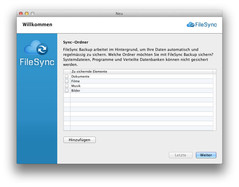
Verdict
Good data protection is absolutely necessary for trouble-free operation of a notebook, because ruined data can ruin months or even years of work. If there's a current backup copy, in cases of emergency you can rest easy and replace the defected data with the copy. Where the data should be saved is dependent on how much data you need backed up as well as personal preference. USB sticks and blank DVDs are good for smaller amounts of data. A hard drive can save all data, including the operating system. Online storage spaces offer access from anywhere, but you have to trust the provider and have a fast Internet connection. The most important thing for good data protection is simply that it's done regularly. That is the only way to ensure that after a catastrophe, work can keep going from where it was interrupted.




